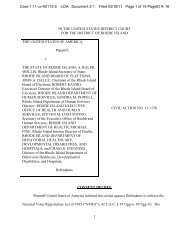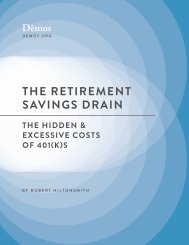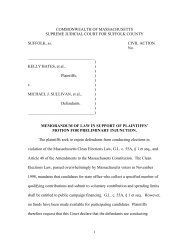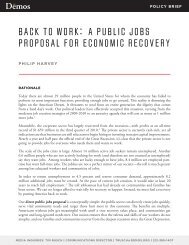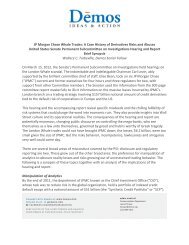The Foundations of Durable Racial Inequality, 1940-2013 - Demos
The Foundations of Durable Racial Inequality, 1940-2013 - Demos
The Foundations of Durable Racial Inequality, 1940-2013 - Demos
Create successful ePaper yourself
Turn your PDF publications into a flip-book with our unique Google optimized e-Paper software.
affects an individual’s eventual Social Security benefits and access to unemployment compensation.<strong>The</strong> problem, <strong>of</strong> course, is that this not only tilts welfare state benefits towardwhites, and thus is an element <strong>of</strong> the (until very recently) economic stability <strong>of</strong> most whiteAmericans; it also calls the legitimacy <strong>of</strong> the welfare state into question.In order to see how the relationship between labor market competition and the welfarestate unfolded for blacks and whites, we examine first the history <strong>of</strong> labor markets since the<strong>1940</strong>s and then the implications for the distribution <strong>of</strong> social welfare.OPPORTUNITY HOARDING AND RACIAL LABORMARKET COMPETITION SINCE THE NEW DEAL<strong>The</strong> last 73 years <strong>of</strong> economic history is usually divided into two periods—a prosperouseconomy <strong>of</strong> rising real wages and income among all classes and groups between 1945-1972,followed by 40 years <strong>of</strong> stagnating wages, particularly for non-college educated workers,and rising income and wealth inequality. All social classes rode up the income and employmentelevator in the 1950s and 1960s, and all but the top 10 percent or so languished on aneconomic treadmill going nowhere after 1973. Real family income for all income quintilesgrew, on the average, 2.2 to 2.5 percent in the first period, but in the second period thebottom 40 percent <strong>of</strong> the income distribution lost ground or faced stagnant incomes. Onlythe top 20 percent gained, yet even this group, on average, only gained about 1.2 percent.<strong>The</strong> real income gains in this period, it is well known, were grabbed by the top 1 percent <strong>of</strong>earners (Krueger 2012, figure 1). Similarly, both black and white workers prospered in thetwo decades after World War II and suffered from the six recessions and the deindustrialization<strong>of</strong> manufacturing after 1973. Yet neither the gains <strong>of</strong> economic growth nor the pain<strong>of</strong> recessions and economic change have been distributed equally among blacks and whites.Whether measured as family income or personal income, the wages and salaries <strong>of</strong> AfricanAmericans have lagged behind whites throughout both periods. <strong>The</strong>re is no doubtthat African Americans made real income gains during and after World War II. Real blackmedian family income doubled between 1947 and 1972, as did the median income <strong>of</strong> whitefamilies. Black families gained relative to white families; the ratio <strong>of</strong> median family incomeincreased to 59.5 percent from 51.2 percent. Yet the absolute median income gap betweenblack and white families increased over this period by almost $5,000, a 35 percent gain forwhites. In fact, blacks lost ground to whites by the late 1950s and only regained momentumduring the economically booming 1960s. After 1973, even though the median familyincome <strong>of</strong> both whites and blacks rose by a little over one-fifth, black family income stilllagged substantially behind Non-Hispanic whites. <strong>The</strong> ratio was unchanged: 57.4 percent in1973 and 58 percent in 2011. <strong>The</strong> absolute income gap also widened by another $5,000, andover the entire 73 year period this gap grew by 115 percent. Even so, these data overstateblack economic gains over the last 35 years since they exclude African Americans who wereimprisoned during the incarceration boom (Pettit 2012).6 • DIVERGENT FATES: THE FOUNDATIONS OF DURABLE RACIAL INEQUALITY, <strong>1940</strong>-<strong>2013</strong>








